It appears the hawks and bears may have scared away the doves and bulls, at least in the short term. In the first half of 2022, surging inflation, and expectations for accelerated Federal Reserve (Fed) interest rate hiking dominated market sentiment, and market returns showed it. In the second half, we expect inflation, higher interest rates, and market volatility to remain front and center, but with added emphasis on how these factors challenge the consumer and their spending. Excess pandemic savings put the U.S. consumer in a relatively strong position. However, the big question is whether it will be enough to stave off a recession. Overall, we believe labor market strength holds the keys to consumer spending and U.S. recession risk. Should economic growth turn negative, the U.S. economy currently faces fewer negative feedback loops, reducing the risk of a severe recession.
Key Takeaways
- Recessions are typically deeper when multiple cycles contract simultaneously. Currently, the profit cycle is weak while the areas that impact the real economy remain strong. Should a recession occur, its scale is likely to be limited by the reduced number of negative feedback loops.
- Soft or hard landing, inflation protection and quality remain essential. Reduced profit expectations increase the focus on defensive positioning and quality. We expect elevated inflation to continue into 2023 due to the lagged impact of food supply disruption and elevated energy costs.
- We’re entering a new era of security. Three key security focuses include energy security, food security, and cybersecurity.
- The balance between interest rate sensitivity and growth sensitivity currently favors value. Should economic growth deteriorate, defensive sectors may become more important than cyclicals, growthier areas may look more appealing if economic growth slows and the interest rate environment improves.
Inflation Has the Fed and Global Central Banks Playing Catch-Up
In our view, markets expect weaker economic growth and higher inflation than central banks have been openly admitting. We expect the inflation trajectory will likely remain a focal point for the second half of the year as markets assess how long inflation will remain above normal levels.
Higher energy and food prices are major culprits in the current scenario. While they are removed from core inflation, energy and food prices are the most visible everyday prices, and therefore have the largest impact on inflation expectations.
We expect inflationary pressures on food and energy to persist, particularly with Europe committed to moving away from Russian energy. Along with higher energy costs, we expect droughts and higher fertilizer costs to weigh on future crop yields, further exacerbating food prices. Additionally, shelter prices and services inflation are expected to increase core inflation.1
After the news that U.S. CPI reached a new peak in May, the Fed raised policy interest rates 75 basis points (bps) to 1.75% in June. This was the Fed’s largest rate hike in 28 years and opens the potential for a more aggressive rate hiking cycle during the second half. Currently, market expectations put year-end policy rates at roughly 3.5%, a staggering increase from 0.25% at the beginning of the year.2 Currently, U.S. policy interest rates are at their pre-pandemic levels. Should this hiking trajectory persist, which we expect, policy rates are likely to reach 2008 levels by year-end.
Inflation isn’t just a U.S. story. Over the last year, inflation has increased at a faster clip in Europe than the U.S. A year ago, inflation in the Euro Area and UK was below 2%. Currently, it’s more than 8%.3 The Bank of England raised interest rates 25 bps to 1.25% in June, the fifth consecutive increase since December 2021. The hike brought UK policy yields to their highest levels since 2009. Similarly, the European Central Bank (ECB) shifted to a more hawkish stance to combat rising inflation pressures. The ECB is set to end their asset purchases in Q3 and increase interest rates by around 175 bps by year-end.4
Lesson: Don’t Fight Central Banks
Historically, the correlation between global equity markets and the size of central bank balance sheets is high, which aligns with the famous adage, “Don’t fight the Fed.” Over the last decade, low yields and high liquidity were a boon for markets. But we’re at the end of the cheap money era that dominated the last decade. Quantitative tightening (QT) began in June, with $30bn Treasuries and $17.5bn mortgaged-backed securities expected to roll off the Fed’s balance sheet monthly.5
With rates moving meaningfully higher and QT under way, liquidity in the Treasury market is weaker and interest rate volatility has increased. Volatility is likely to remain elevated as the market adjusts to its new reality.6
Resetting yields back to pre-quantitative easing (QE) levels will likely be a painful process for markets. Higher Treasury yields and reduced liquidity has implications across asset classes, and this combination has and likely will continue to result in a higher correlation between equities and fixed income. On average, since 2000, equities and bonds offer a negative return correlation. However, from the late 1970s until 2000, equities and bonds typically had a higher correlation. Year-to-date correlations are back to pre-2000 levels, creating headwinds for multi-asset portfolios, at least for the near-term.
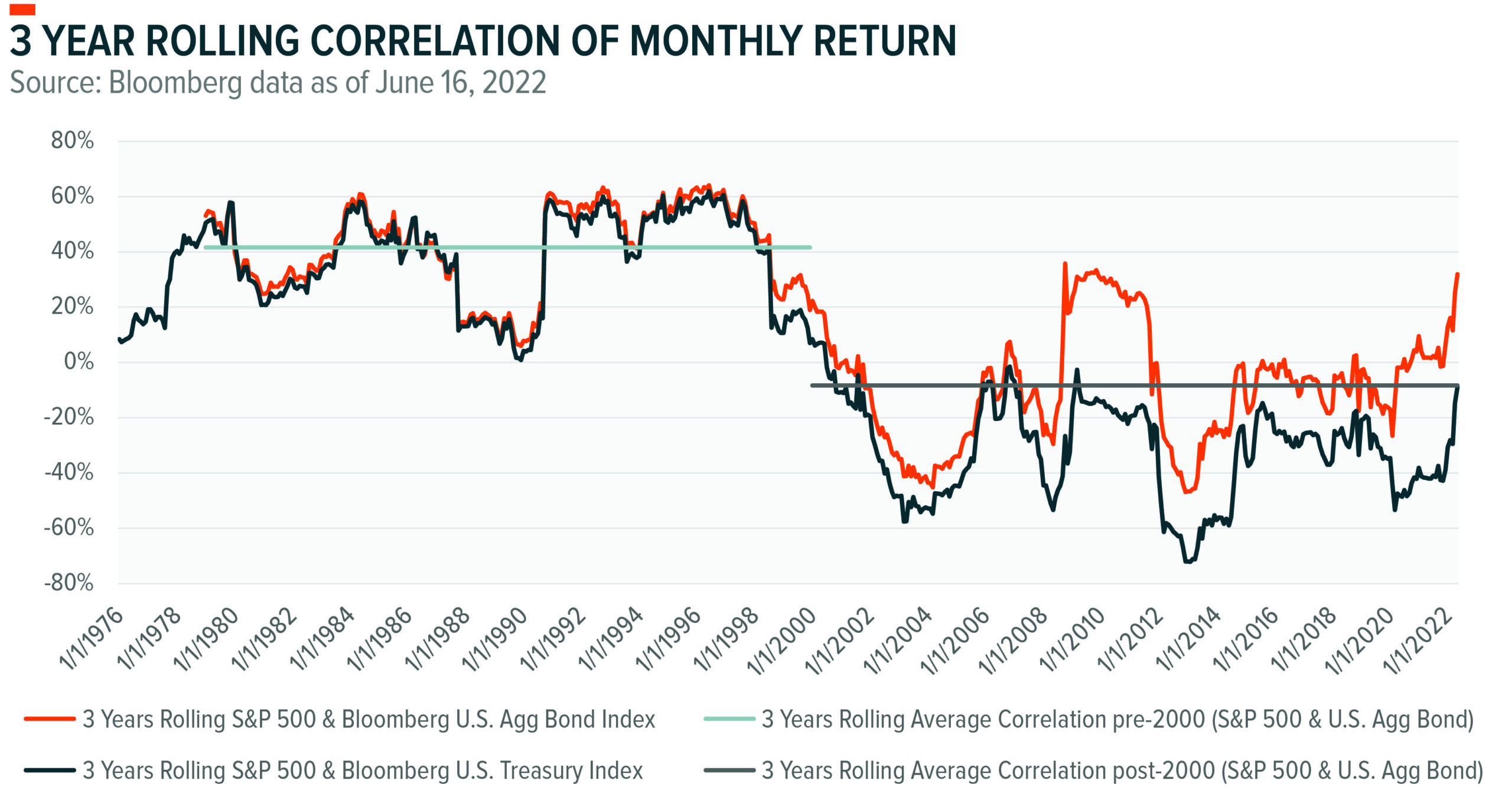
A New Era for Fixed Income Begins
In investment circles, the TINA effect, or “there is no alternative,” has been in place since the Global Financial Crisis. With fixed income yields so low and cash earning next to nothing, equities were the “only” asset class investors could go to generate returns. However, the TINA era is nearing its cycle end.
The yield difference between fixed income and the earnings yield on the S&P 500 is starting to narrow. While fixed income is likely to remain a challenging space as policy yields rise to their terminal rate, Treasuries potentially can offer value.7 The short end of the curve has risen to reflect higher policy rates, while the longer end has flattened. The Fed’s commitment to bring inflation under control creates headwinds for equities and fixed income. However, as recession risks rise, fixed income, especially Treasuries, is likely to outperform equities.8
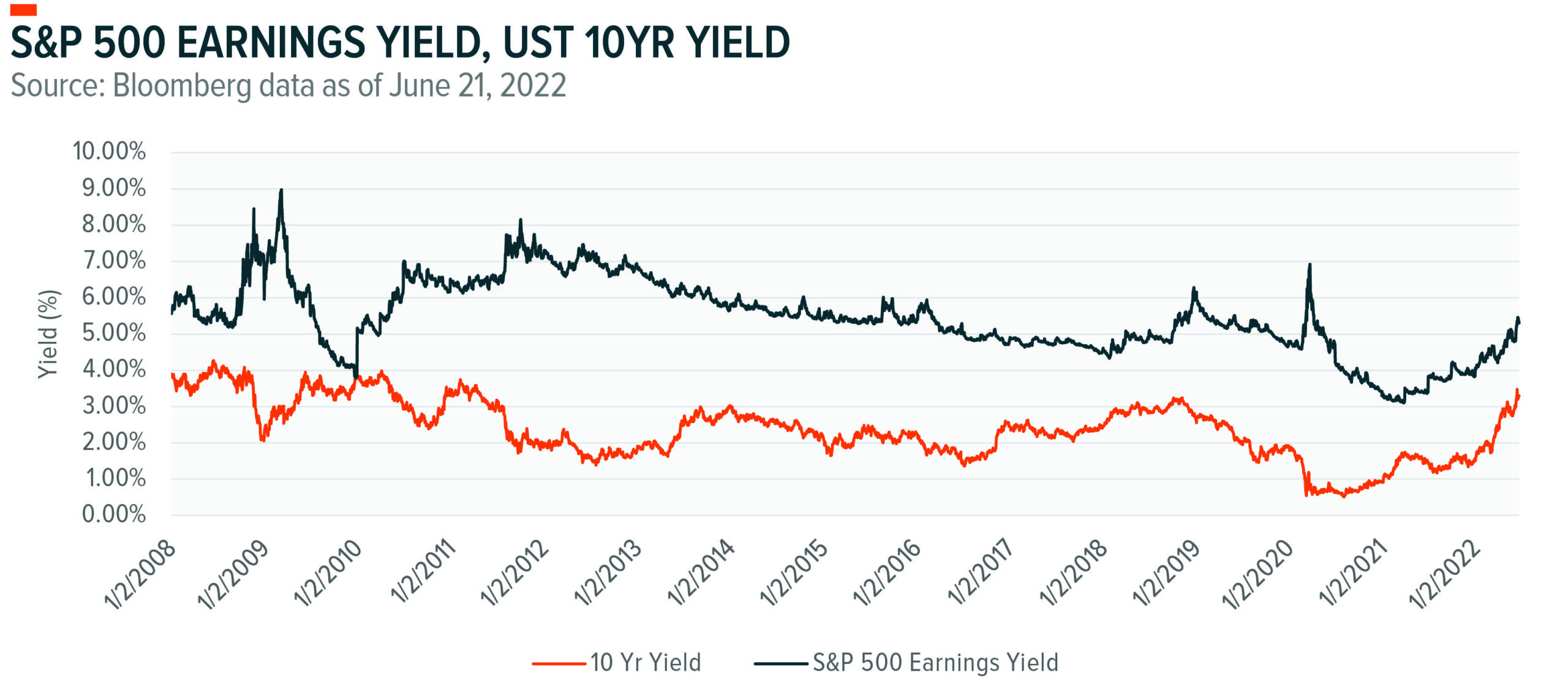
Economic Risks Rising Around the World
Rising interest rates, the war in Ukraine, supply chain disruptions, and China’s zero-COVID policy have created economic uncertainty around the globe. Each global region has its own unique challenges. These asynchronized risk factors may have spillover effects on regional and global economic growth.
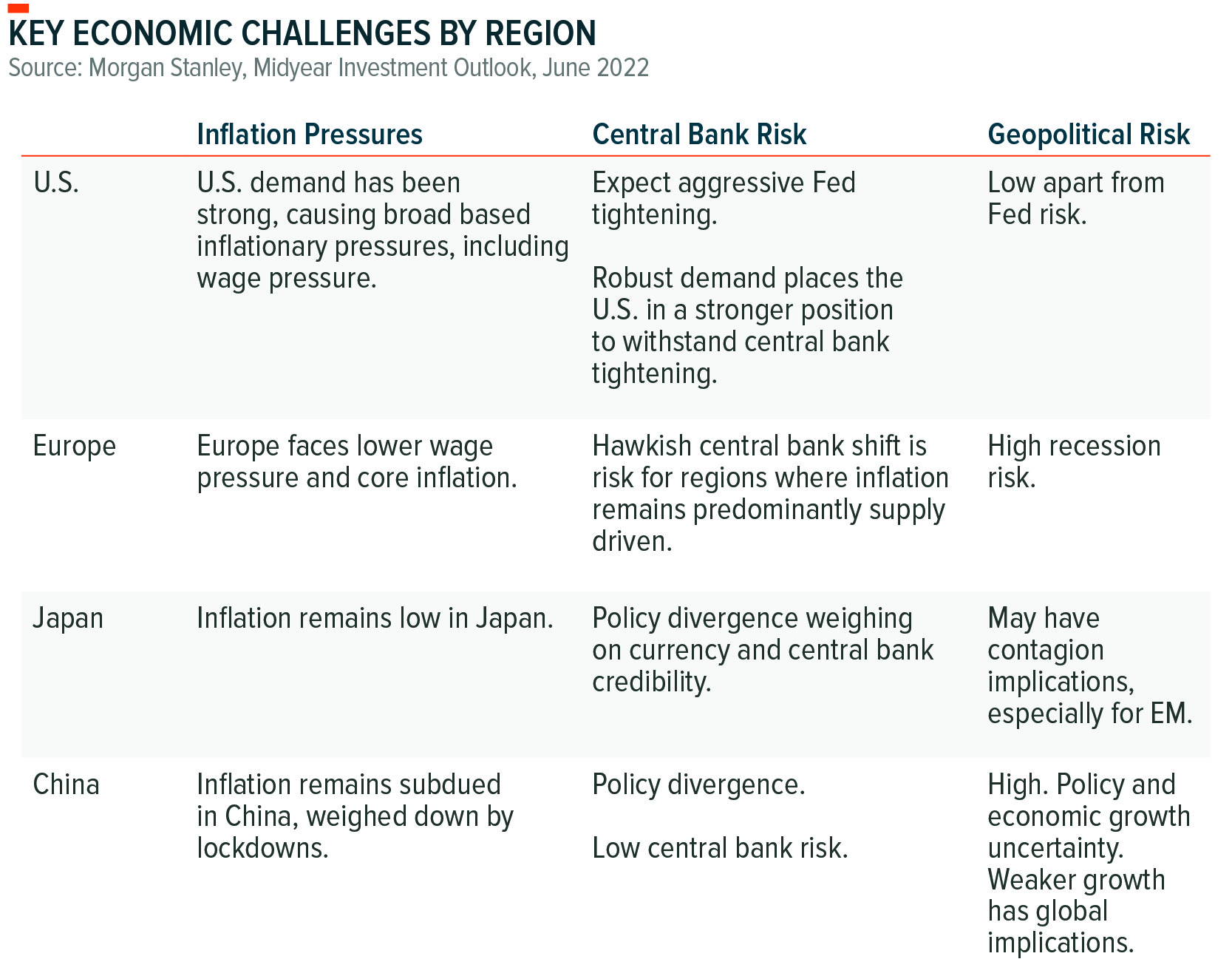
In the U.S., the current economic slowdown can be described as slowly edging towards a recession, and companies are starting to come to grips with it. According to a survey of 750 CEOs conducted between May 10 and 24, more than 60% of respondents indicated that they expect a recession in their firm’s primary geographic operating region in the next 12 to 18 months.9,10
Against this backdrop, the U.S. economy and the U.S consumer is going into this slowdown in a stronger position than other regions. Additionally, given the U.S.’s stronger demand situation, monetary policy is likely to be more effective. The hawkish central bank shift remains a risk for regions like Europe, where inflation remains predominantly supply driven.11
Severe U.S. Recession Risk is Limited
U.S. recession probabilities are rising, but a soft landing remains possible. Should a recession occur, severity risk is an important consideration. At this stage, we do not believe the U.S. is at risk of a severe recession as negative feedback loops remain limited. Typically, a recession is deeper when multiple cycles contract simultaneously. Currently, the profit cycle is weak, while the areas that impact the real economy remain strong. A profit recession hits corporate valuations. However, it does not necessarily have the full-scale feedback loops of a full economic recession.
- Pricing pressure is starting to be felt on the margins as companies right-size inventory levels after supply bottlenecks altered typical supply timing and levels.12 Inventory delays and the shift in U.S. purchasing patterns from goods to services are likely to drive steep discounts. Large items that are expensive to store, such as furniture, are likely to be discounted the most.13 According to Bank of America analysis, global profit expectations are at their weakest point since the Global Financial Crisis, increasing the risk of a profits recession.14
- The capex cycle does not appear to be overinvested and significant deleveraging in the housing cycle is unlikely.15 Existing housing inventories are at multidecade lows, and banks are healthy.16 Manufacturing remains in expansionary territory, and consumers and corporate balance sheets are strong.17 Additionally, the U.S. is a net energy exporter.
With lower profits in focus, reduced consumption combined with rising unemployment remain the largest U.S. recession risk. Consumers enter this slowdown with a large savings cushion, and inflation expectations may encourage consumption. However, wage growth has not kept pace with inflation, and market drawdowns have reduced wealth. These factors may increase consumer sensitivity to drawing down savings and increasing their borrowing, which could become more evident should unemployment rise.18
It is encouraging that the labor market is expected to remain tight for the next year. According to Morgan Stanley, labor force participation is expected to rise, but the unemployment rate is likely to remain rangebound at about 3.4% until the end of 2022.19 However, as profit and margin pressure increase, companies may need to right-size employee numbers in line with reduced demand and expectations for slower economic growth in 12 to 18 months. The shift from goods to services combined with fewer workers being out on COVID-related sick leave changes the productivity dynamics for retailers, shifting staffing situations from understaffed to overstaffed. This dynamic has been most notable for large e-commerce retailers that increased capacity in line with pandemic goods demand.20
Europe: 2022 Recession Risk May Depend on the Flow of Russian Gas
If gas keeps flowing, a recession remains unlikely. Euro Area real GDP expected to increase 2.5% in 2022. With rising inflation and growing economic concerns, this forecast is substantially weaker than the 4% growth forecasts from the beginning of the year.21 While the impact of higher energy prices has been felt globally, it has had a more dramatic impact on European consumer inflation. Euro Area inflation rose from 2% in May 2021 to 8.1% a year later.22 Conversely, U.S. inflation was already elevated in 2021. Over the last year, U.S. headline CPI increased from 5.0% to 8.6% in May 2022.23
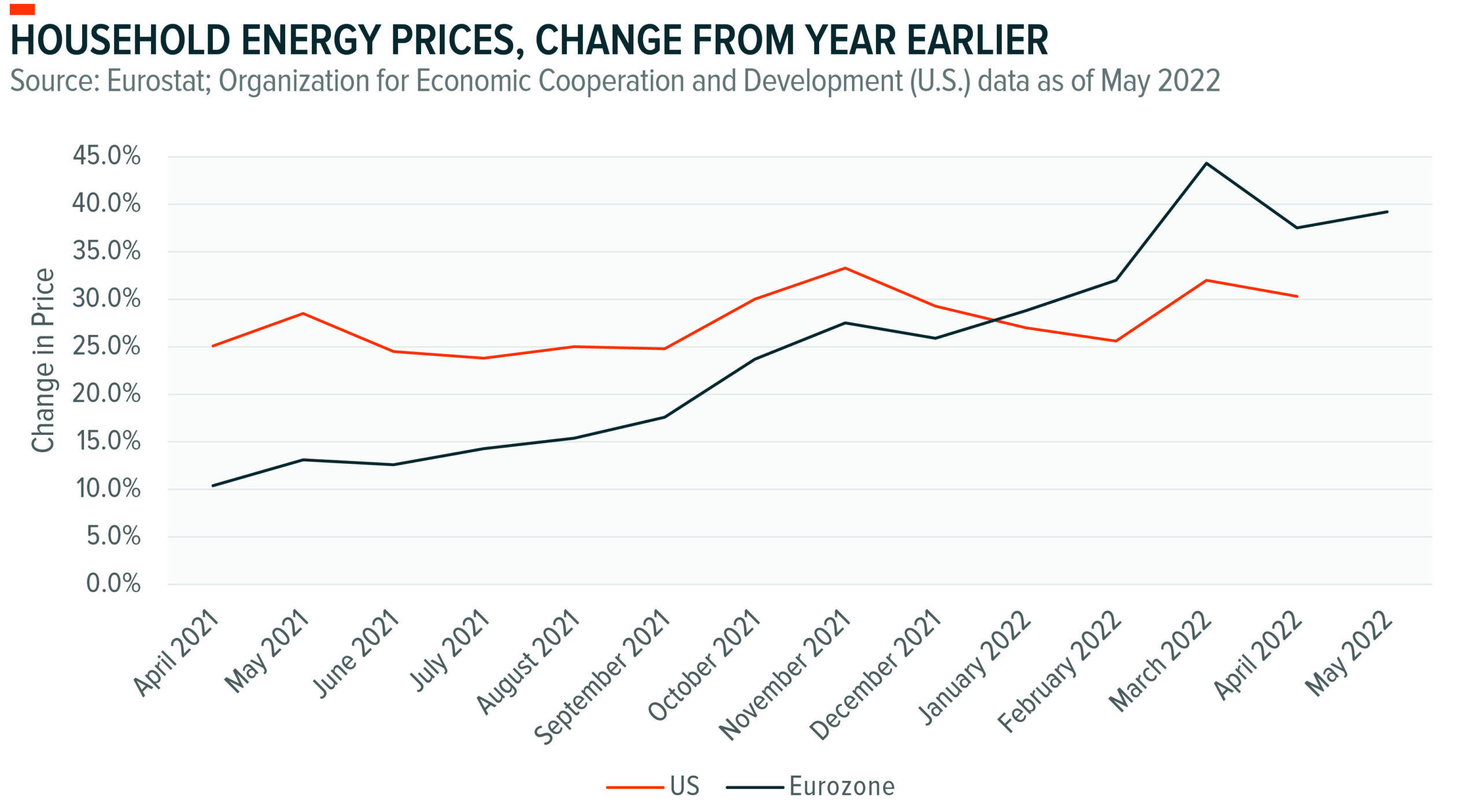
Europe committed to cut ties with Russian energy by 2027,24 but Russia is using natural gas as an economic weapon and testing Europe’s resolve. Elevated inflation and economic weakness may reduce Europe’s willingness to support a drawn-out conflict. In mid-June, Russian gas supplies to Europe slowed. Germany, Europe’s largest importer of Russian gas, received only 40% of the gas they requested. Italy received 50% of the gas they requested. Gas flows into France declined 60% during the first five months before stopping during the week ended June 17, 2022.25
European gas shortages are unlikely this summer, as consumption tends to decline in the warmer months and Europe has plenty of gas in storage. However, concerns are mounting for the fall and winter. If Russia cuts off or reduces gas supplies, the German economy is a major concern because it lacks access to LNG.26 To alleviate this concern, Germany is constructing an LNG terminal in the North Sea. According to Germany’s economic minister, Robert Habeck, two of their four LNG converting ships are expected to be operational this winter. Germany aims to have their gas storage tanks at 90% of capacity by December. However, currently these tanks are only 56% full.27
Europe has made good progress at filling their gas tanks due to increased LNG exports from the U.S. and reduced energy demand from China.28 But Europe is running out of options to increase energy storage without Russian gas. A fire at a major Texas LNG plant may reduce U.S. LNG exports for the rest of 2022, while rising Chinese demand could shift supply away from Europe. Nord Stream is the largest conduit for energy into Europe.29 Reduced gas transportation through that pipeline and into Italy complicates Europe’s ability to reach their target of filling their gas stores to 80% of capacity by November.30
Asia: Uncertain Economic Growth and Policy Divergence Create Headwinds
China remains a wildcard for global economic growth. Demand may rebound, but China continuing their zero-COVID policy keeps the risk of future lockdowns in play. Strict lockdowns in the first half caused economic growth expectations to be downgraded. Additionally, policy risk and the fallout from the Chinese housing slowdown remains to be seen.
From a global inflation perspective, reduced Chinese demand may have positive implications for energy and commodity demand. Conversely, Chinese economic weakness may have adverse implications for countries that rely on China for export demand. Europe and the Asia Pacific region are large trading partners with China.
In Japan, the yen is at its weakest levels in 24 years due to hedge funds shorting Japanese bonds to pressure the 0.25% yield cap on the Japanese 10-year government bond. This currency crisis rings warning bells for emerging markets (EM), where domestic demand is subdued but supply driven inflation pressures are rising. Rising food and energy costs combined with U.S. dollar strength and the Fed’s commitment to tackle inflation may bring currency and debt risks for EM countries. An escalation in Japan’s currency crisis could result in a flight to safety and away from EM currencies and capital markets, which may in turn raise contagion risks.
The Bank of Japan can either defend their yield curve control, or their currency.31 Prices in Japan have started to rise, but the Bank of Japan is one of the few central banks that has not shifted to a more hawkish tone. Japan faced deflation pressures less than a year ago, with only the last two inflation readings rising above 1%. April’s inflation increased sharply to 2.5%.32 But this policy divergence created a unique situation where hedge funds started pressuring the value of the Japanese yen.
In an export-oriented economy, a weak currency can make that country’s products more competitive. But the scale of the decline in the yen raises concerns about currency stability and the Bank of Japan’s credibility. The government and central bank expressed concerns about the yen’s decline and indicated that they are prepared to intervene if necessary. However, currency intervention is expensive and risky because it involves selling dollars and buying yen, which can lower currency reserves. It is not a decision made lightly. The Asian financial crisis of 1998 was the last currency intervention in Japan.
Sharp capital outflows across the yen, domestic stocks, and bonds may prompt a currency intervention. At $1.33 trillion, Japan has the second highest foreign currency reserves globally, which puts Japan in a stronger position than most countries to withstand these currency concerns.33
Positioning for a Bumpy Second Half
We believe the market is in a late cycle environment, and at this stage, the two contrasting forces are interest rate concerns and economic growth concerns. In our view, recession risks are currently higher internationally, and we maintain our preference for U.S. equities despite international markets trading at a discount.
While economic growth concerns are high, the war in Ukraine is likely to keep inflation risk elevated regardless of if the economy dips into negative territory. As outlined in the table, we believe this creates an environment where several of the key positioning considerations are similar regardless of the state of economic growth.
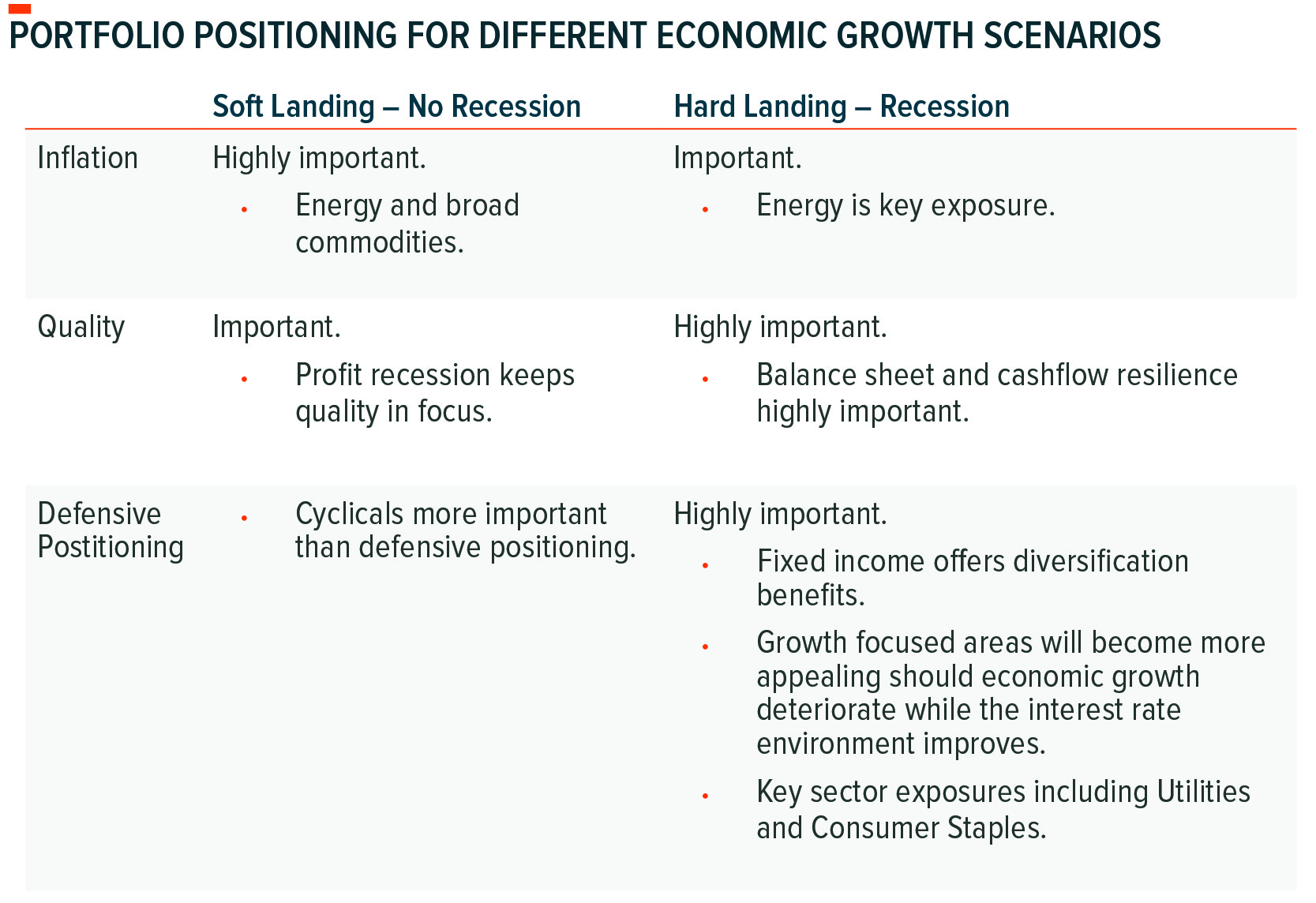
Reduced profit expectations could shift focus to defensive and quality
Global profit expectations are at their lowest point since September 2008. Historically, a sharp decline in global profit expectations occurred during all other Wall Street crises.34 Reduced profit expectations increase the focus on defensive positioning and quality.
Typically, value stocks outperform growth during periods where inflation exceeds 3%.35 Value with a tilt towards quality and energy speak to rising margin pressures and energy’s importance in the current inflation pressures. As economic growth slows, defensive sectors are likely to become more important than cyclicals, except for the Energy sector. Historically, the Utilities sector is negatively correlated with inflation, but during periods of stagflation its defensive properties are valued. The Consumer Staples sector is similar.36 Decreasing real disposable income is likely to contain consumer spending, focusing on necessities.
Growth stocks are more sensitive to interest rates than economic prospects. Should the interest rate environment improve while economic growth deteriorates, growthier sectors such as Technology may look more appealing during the recovery.
Fixed income may be a haven as economic concerns mount
Fixed income, and particularly Treasuries, may outperform equities during periods of heightened economic growth concerns. But overall, rising interest rates create headwinds for equities and fixed income.37 Central banks are likely to remain a source of volatility in the second half. They’re currently in uncharted waters, aggressively mopping up liquidity while striving to avoid a hard landing.
Europe’s situation illustrates opportunities in security – food security, energy security, and cybersecurity
The conflict in Ukraine increased geopolitical risks while having implications for globalization, currencies, inflation, cybersecurity, and climate change. Combined with higher interest rates, these factors contributed to the equity risk premium rising during the first half.38 While the higher discount rate weighed on equity markets, the conflict and its impact on commodity supplies established a new era of security. In our view, this scenario creates key portfolio positioning opportunities focused on three key security areas: energy security, food security, and cybersecurity.39
Europe’s energy crisis and the developing food security concerns speak to several key areas, including protecting against inflation, and positioning for current and future needs. For example, commodities typically perform well during inflationary periods, and with the Ukraine conflict, we believe that commodities offer a degree of geopolitical risk protection and benefits due to the energy transition.
Within commodities, the Energy sector is more favorably positioned relative to metals. Energy demand continues to outpace supply and global inventories are low. Another factor keeping supply limited is a long cycle of under-investment in commodities. Morgan Stanley estimates the oil undersupply is likely to be around 1 million barrels a day for the rest of 2022. Conversely, metal demand is typically sensitive to Chinese demand.40 Overweight Energy sector exposure may be a way to protect against the impact of higher energy costs elsewhere in a portfolio.
Near term, the shift in sourcing away from Russian energy creates opportunities for fossil fuels and energy-producing countries such as Canada and Norway. As Europe reduces its dependence on natural gas, alternative sources of fossil fuel energy, such as coal, may experience a short-term demand increase. However, European energy independence raises the importance of the energy transition from fossil fuels to renewable sources. This transition will take time and is likely to remain a key area of investment over the next decade.
Growing food insecurity, exacerbated by the war-induced energy crisis, is a growing risk. In our view, innovative food solutions that AgTech brings to the market can create compelling long-term investment opportunities.
Cybersecurity risks increased as the world became more digital and connected. The WFH transition and the war in Ukraine highlighted the importance of data protection in the digital age. Cyber war and risks of retaliatory cyber-attacks remain an element of the war in Ukraine. The current security focus increased the emphasis on cybersecurity, but this theme is likely to remain critical for decades as the importance of data protection is unlikely to diminish.
Conclusion
Investors have faced challenges in the first half of 2022. While the discount rate dominated the first half, we expect economic growth will be in focus in the second half of this year. We believe diversification across inflation protection, defensive positioning, and quality value are key. The balance between these three focus areas may tilt as the interest rate and economic growth environment shifts.
Should the U.S. economy experience consecutive quarterly contractions, we expect this recession to be milder as negative feedback loops are currently limited. Although growth is slowing, the U.S. economy remains in a reasonably solid position. But economic slowdown or shock factors from international economies may impact U.S. exports and corporate earnings. This may feed into profit recession expectations and potentially result in a reduction in hiring and lower consumption.
 Michelle Cluver
Michelle Cluver